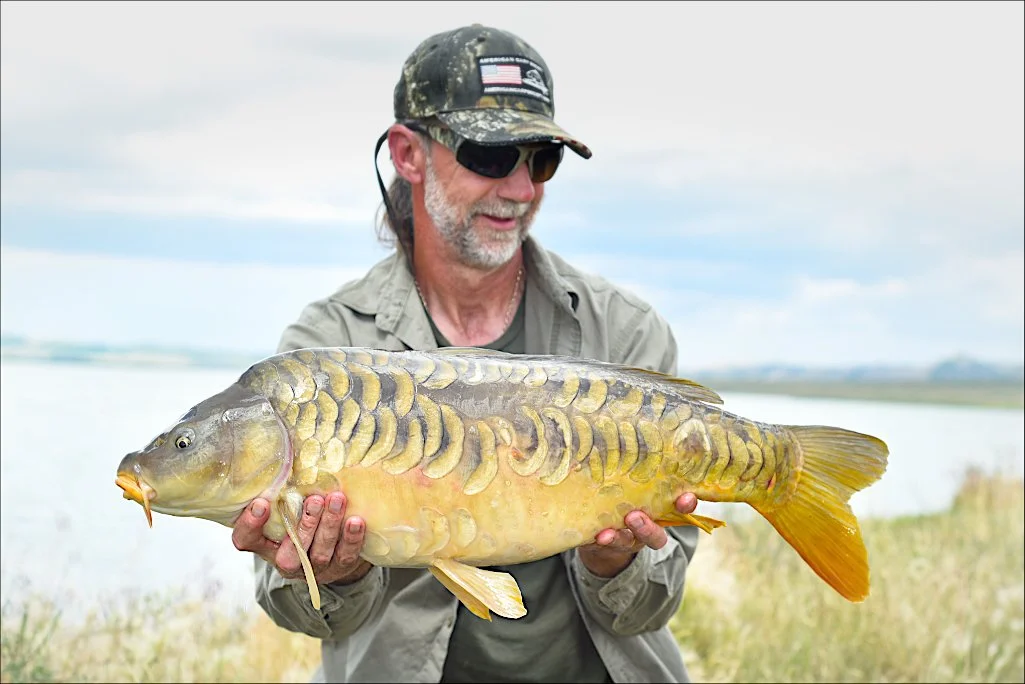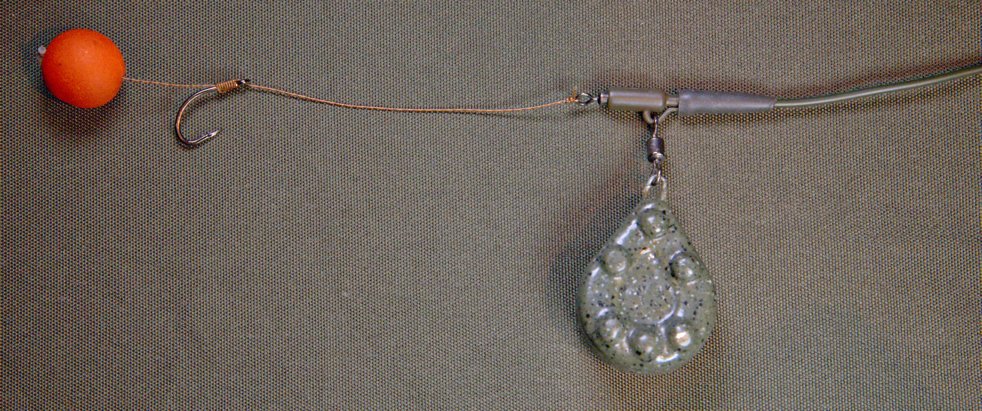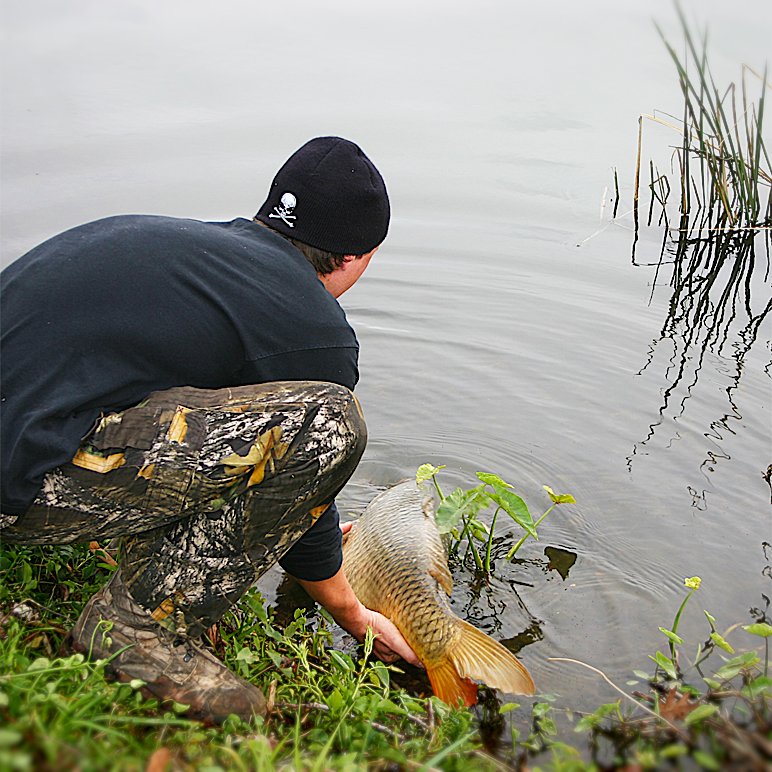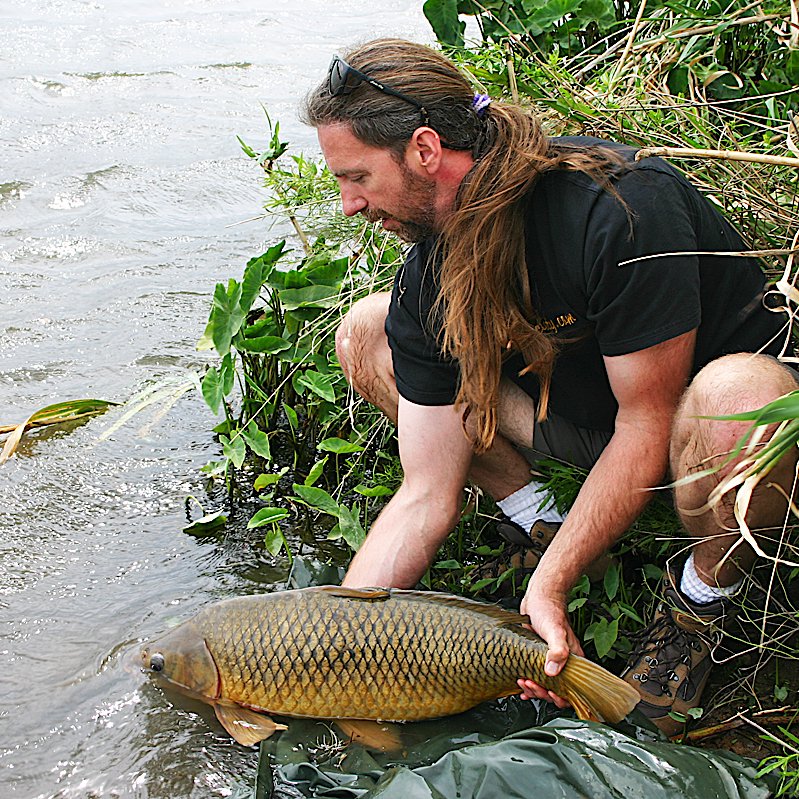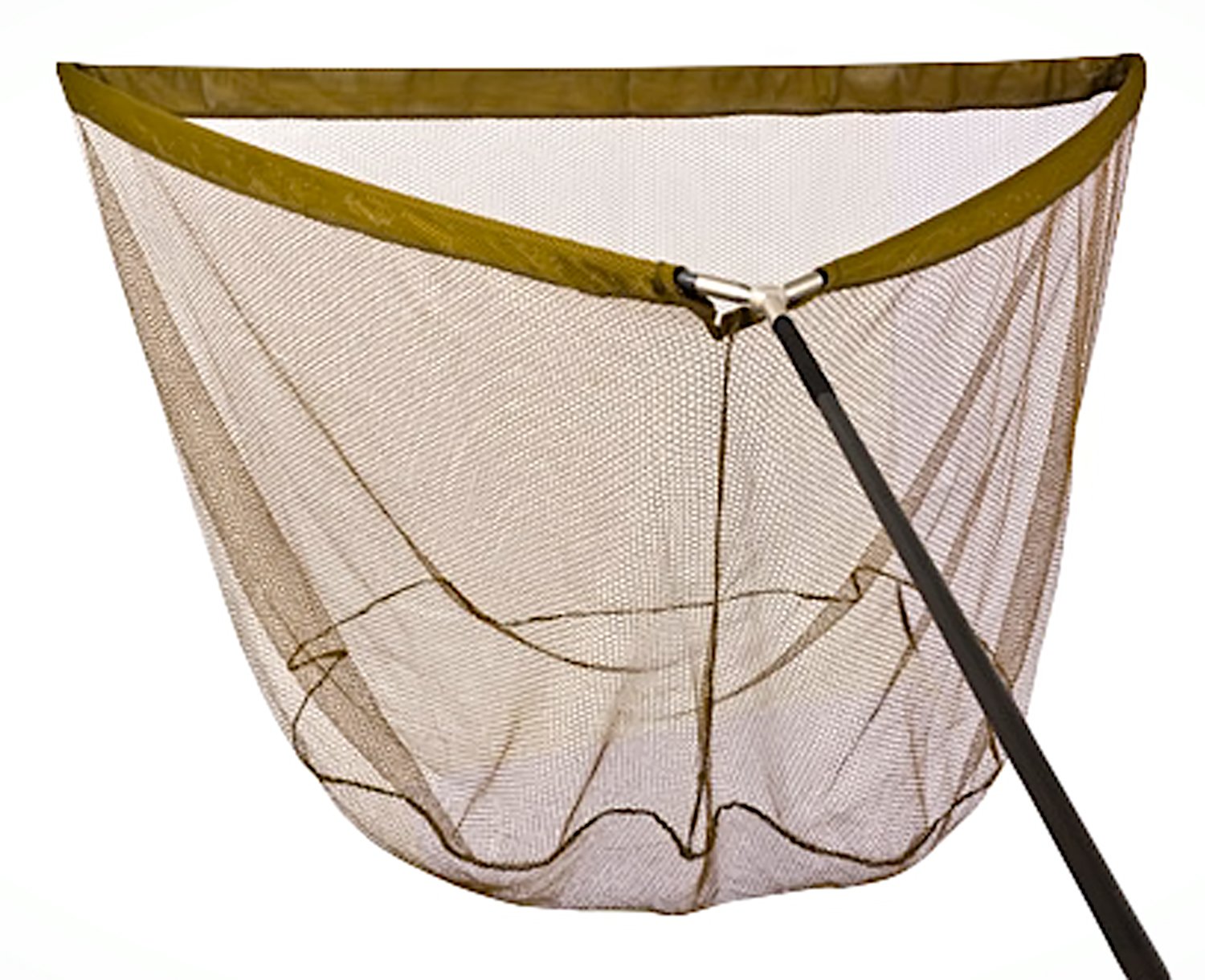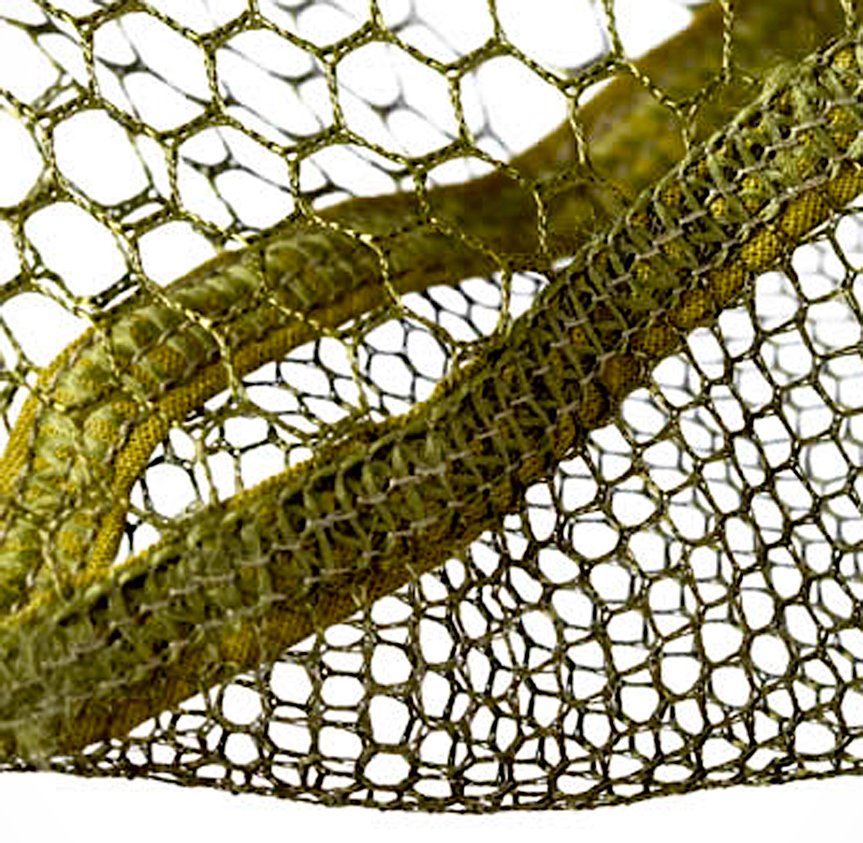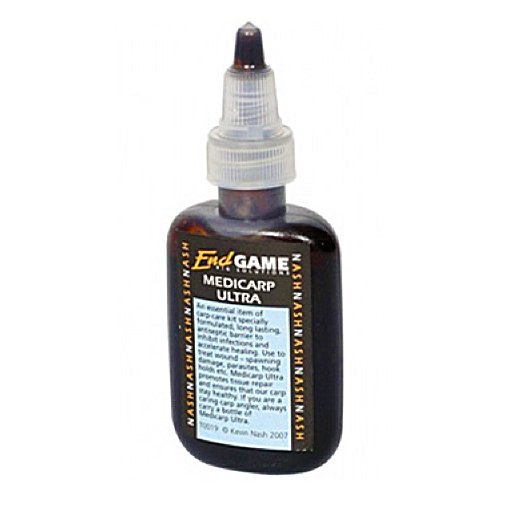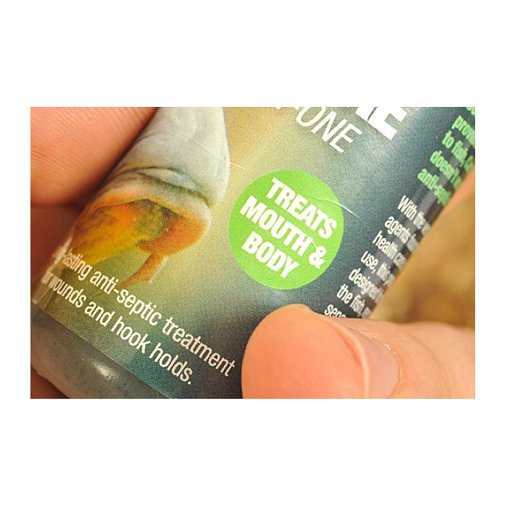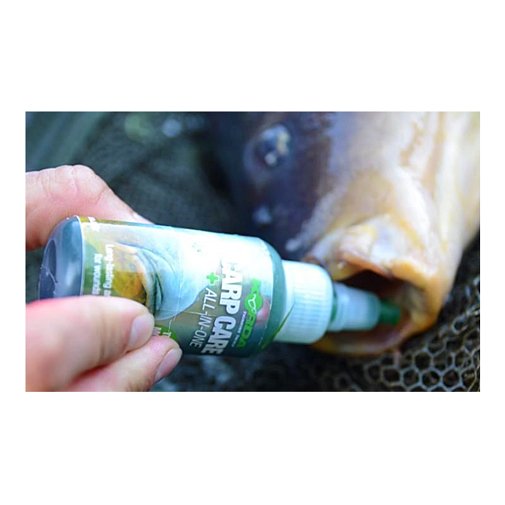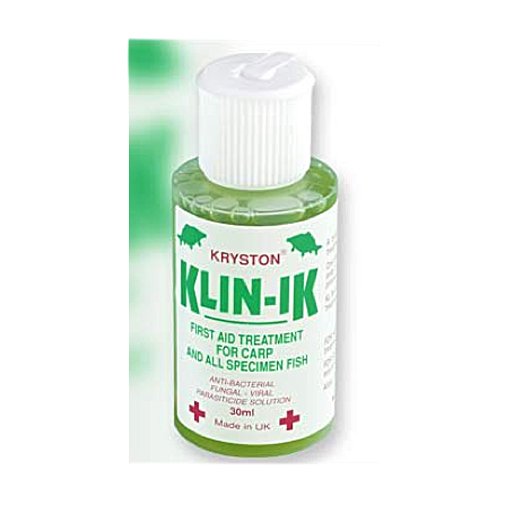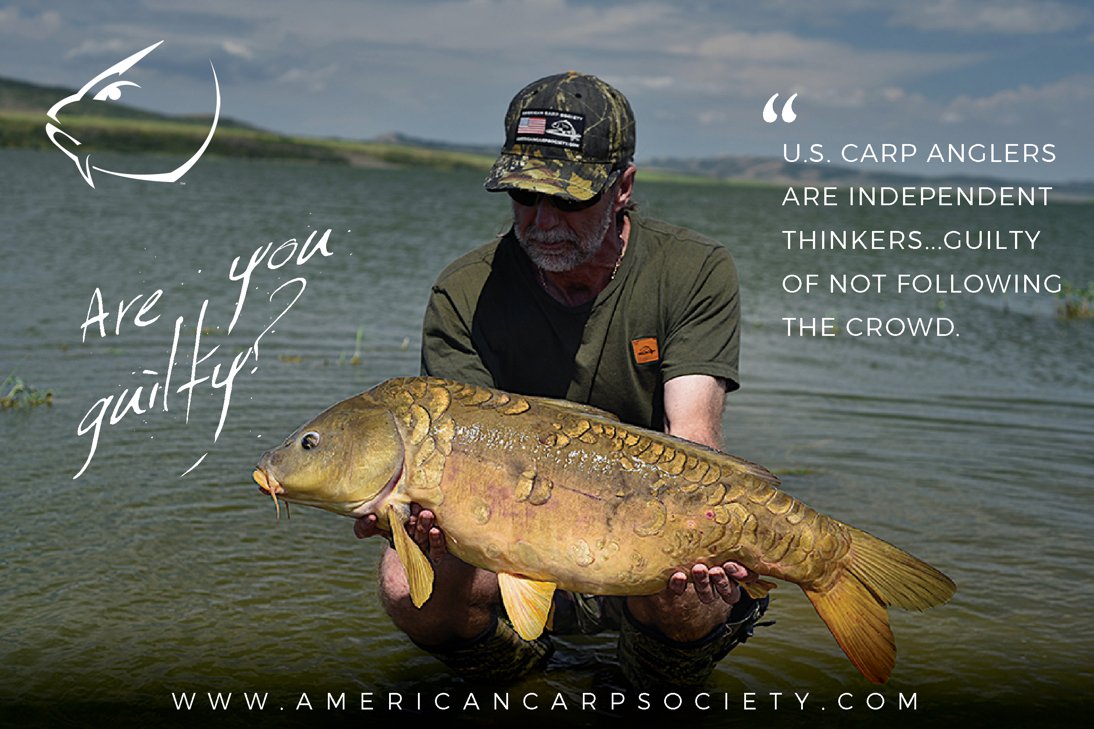USA Carp Angling Intro - Part 3
by
Wayne Boon
Hello again and welcome to the 3rd article in this series designed to introduce and instruct anglers on the new age of Carp Angling…
We’ve recently covered many of the basic concepts and techniques commonly employed to catch carp; this month, we’ll take a really good look at fish safety which is always uppermost on our minds when ever we are fishing, regardless of specie we’re chasing…
There are two main aspects:
Fish Safety while actually angling.
Fish care & safety while the fish are in our possession; That is, while they’re out of the water for as brief a period of time as possible while we un-hook, measure, photograph before returning them to the water.
While there are unfortunately still some folks out there tutting and rolling their eyes upon reading this; The American Carp Society passionately believe we should lead by example. It’s imperative that we all make it our personal mission to look after present day fish stocks, regardless of the specie or reason we are angling for it…our children and grand kid’s angling opportunities will depend on our choices and actions right here, right now…
Fish Safety while actually angling
CARP FRIENDLY RIGS - SAFETY CLIPS
The actual name of this important piece of terminal tackle (The Safety Clip) gives one of the main reasons for its use away but more on that in the following paragraphs…
To be used effectively, the safety clips requires there main parts to fit together perfectly and working harmony. Four parts if you include the lead weight which ideally have a swivel attached to its wire loop. (see examples below)…
The three main parts are: A swivel, the safety clip itself and a tail rubber. Ideally, purchase all three parts from the same manufacturer as you will be guaranteed that they are all designed to fit and work together correctly. At the very least, make sure the same manufacturer has designed the clip and tail rubber, the swivel should be a size 8 but one or two clips are designed to take a size 7 swivel. Either way, the swivel should fit snuggly into the barrel end of the safety clip. Some models even provide a little plastic pin to hold the swivel in place.
So what does the Safety Lead Clip actually do and how do we utilize it when we tie up one of our bolts rigs?
First, the clip should of course hold the lead weight securely enough during the cast to enable us to get our baited hook out to the desired location on the lake/river bed without the lead weight/sinker breaking away from the clip during the cast and potentially hitting someone or something on the far bank.
Of course, if we’re using heavy lead weights and really compressing the rod for some serious distance casting, then a shock leader (a couple of rod lengths of heavier mono tied to you mainline to safely take the force of the cast) should also be employed for extra safety to prevent crack offs (line snapping during the casting process, sending the rig and sinker heading uncontrollably towards the horizon somewhere).
The main line or shock leader should be threaded through the pointed end of the tail rubber first and then through the neck (thinner end) of the safety clip itself.
Clip and tail rubber threaded onto mainline.
Having already threaded the Tail rubber and Safety clip onto the mainline/shock leader as noted above, the mainline or shock leader is then tied to the other eye of the hook length's swivel before firmly pushing the swivel into the safety clip barrel as illustrated. A typical hook length complete with a size 8 swivel is shown below.
Some concerned anglers even take a further safety precaution by cutting the plastic retaining arm back a little to ensure the lead weight comes free from the clip in certain circumstances.
Cutting the clip arm back to ensure that the lead weight ejects if problems arise during the fight.
Next, we choose which lead weight to use based on the conditions we're fishing and attach it to the safety lead clip as shown below. Using a sinker/weight with a swivel already attached adds to the safety aspect of the rig as there is less likelihood of the weight getting jammed/stuck on the safety clip in the event of a breakage of the mainline with the fish hooked.
Now, one of the most important parts of the process; sliding the tail rubber over both the neck of the clip and the weight/sinker retaining arm. It slides on easier if the clip is lubricated with water or saliva.
The big question is, “how far do we push the tail rubber onto the clip?” Experience is the best judge and it does vary from manufacturer to manufacturer. It’s dependent on the materials the clip and tail rubber are made of but we’d recommend as a general rule, no more than 75% of the neck of the safety clip should be covered by the tail rubber once you’ve pushed them together.
Correct safety clip assembly.
Now that we have the Safety Clip and bolt rig together lets address the three main advantages to its use:
As most anglers who regularly fish in and around weeds and other snags soon find out, it’s the lead weight/sinker that probably catches a tight hold of the weed/snag. How many times have you lost the fish in a weed bed and then dragged in about 50 LB of the green stuff? Or dragged the green mass in hoping to find a Carp buried in the middle of it all but somehow, the crafty carp has gotten away unseen. It’s not only frustrating, it is also very time consuming and a huge tax on all your equipment!
Here is what happens in probably 90% of these cases: Once this very smart fish dives into the weed bed or other snag looking for a haven, the weight/sinker catches a good hold onto the weed. Of course, we try to keep the line as tight as possible thinking we’re in direct contact with the fish… The trouble is, we’re not! We are tight lined to the weight/sinker in the weed but the other side of the weight (hook, hook length and of course the Carp) is slack lined giving the fish lots of room to shake the hook loose and swim off depriving us of the satisfaction of an awesome trophy photo and a great release story. Here is where the safety clip comes into its own, especially in this very weedy situation when the assembly recommendations above have been followed.
If you apply moderate pressure to the fish in the snags (well, the “locked tight in the weeds” weight/sinker), the weight/sinker should very quickly push the soft rubber tail off of the safety clip and actually break free of the clip. This will enable you to keep the line tight all the way to the hook point. Although the weight/sinker is lost, this will enable you to land and photograph many more fish that would otherwise have escaped unseen.
NOTE: An even better scenario is designing the rig so the lead drops off just as the fish bolts with the baited rig when you know weed banks/snags will definitely be involved in the fight. Some anglers achieve this by cutting the safety clip's arm way back, attaching the weight followed by the tail rubber. The weight is then secured with a couple of wraps of PVA string that then dissolves away in the water after the baited rig has been cast out.
You can quickly and efficiently change the weight/sinker size or shape to suit the changing water/weather conditions you can often face during a session without having to change your whole terminal rig.
The third and most important aspect of using this Safety Clip assembly is in actual fish care and safety: Think back to the last time you were fighting a large fish and heaven forbid, the mainline broke for whatever reason whether it be faulty equipment, old nicked or creased line, bad knots, abrasive lake/river beds (rocks or Zebra Mussels) etc. The Carp is going to be towing around the rig, complete with the heavy weight/sinker until it again gets snagged up on the bottom of the lake/river bed. Think of this as your pet dog chained up in the middle of your back-garden lawn, way out of the reach of his food bowl in the kitchen. If he can’t get free to eat enough food to serve his current metabolic needs, he is going to suffer a long and slow death!
But as in example #1 (in the weeds) above, because the weight/sinker is attached to the retaining arm of the clip and not directly onto the line, the buildup of pressure caused by the fish pulling will cause the tail rubber to pop off allowing the weight/sinker too easily work itself free of the safety clip, the fish will live to fight another day. It’s a very simple and relatively cheap piece of kit that serves you, the fish and the bigger conservation/good stewardship picture well.
RIG TUBING
Rig tubing, which is also sometimes referred to as Anti-Tangle Tubing is made of a supple PVC plastic and is used directly above the Safety Clip on the mainline. Some newer versions of this tubing has tungsten added to the plastic during the manufacturing process to add weight, helping to pin the tubing down so it's hugging the lake bottom.
Note: Be careful not to confuse this more rugged PVC tubing with the silicone tubing often used in the hook length/rig construction. Although the silicone tubing would do a similar job, it's almost impossible to thread the mainline through a 24" length of silicone tubing due to it's super supple nature and it's very unlikely to sit anywhere near flat on the lake bed.
As can been seen in the photos below, the mainline is threaded through approximately 18" to 24" of the Rig Tubing. The tubing is then pushed and seated into the end of the tail rubber on the safety clip; it can be secured with a dab of superglue.
Using a 18” to 24” length of Rig Tubing as part of your baited rig presentation has 3 main advantages:
As an Anti-Tangle precaution during the cast.
For protecting your lines from abrasion on very rough lake/river beds.
Protection of the fish during the battle to land them. There is much less likelihood of you damaging the fish by lifting a bunch of scales off it’s flanks during the fight/landing process when Rig Tubing is used.
Many anglers don’t like using Rig Tubing simply because they find it a massive head-ache to thread the mainline through 2 feet or more of the tubing. It can be a hassle, especially with older mainline that is coiling. In this case, it’s probably time to renew the line on your reel anyways to prevent “lost fish heart ache.” Look for a tubing with an internal diameter of at least 0.75mm, 1 mm is best when using a 25-30lb mono shock leader.
Note: We find it hassle free when the mainline section that will be threaded through the tubing is first lubricated with Olive oil or similar. The mainline always passes through the tubing with little or no friction when lubricated like this…
2. Care & safety while the fish are in our possession.
PRACTICING CATCH AND RELEASE
The large trophy fish that we pursue with devotion can take many years to attain such sizes. A 40+ pound fish can be in excess of 30 years of age so for many, the fish can actually be older than the Angler pursuing it!
These great fish can live in excess of 60 years and, though traditionally known as a hardy fish, we advocate to always treat them with care and respect.
It’s also worth remembering that these large fish spend their entire life submerged with their bodies and vital organs supported by the surrounding water pressure. When they are on the bank and being handled by us, this support is no longer there and they are susceptible to damage if not handled correctly.
The preservation of these ‘elder statesmen’ for other anglers to enjoy is something that we 100% advocate.
And lest we forget, they don’t get to be this size by being weak or stupid. Consequently, they’re the best of the best in regards to their gene pool, so we need them back in the water to continue breeding.
So the following section discusses carp care, so that when the fish of a lifetime is captured, it can be released unharmed for others to enjoy.
After all, they give us so much pleasure in their pursuit, it’s the least we can do?
LANDING NETS
Modern day carp nets have been designed with both efficiency and fish safety in mind. The small mesh that is used today will not lift the fish’s scales or cause any tearing of the fins, as the older thickly knotted nets will.
If you do not have a purpose built carp net then a rubber net is the next best option.
The modern carp nets are designed for large fish in excess of 20+ pounds. They are NOT designed however to actually ‘lift’ fish of this size out of the water while holding the net handle in the traditional method. Actually gather the netting around the fish and lift the fish using the netting only.
They usually have a 6ft detachable handle with the width of the actual net being 42”-52” inches.
The actual net is attached to the handle via a spreader block, with the net itself consisting of two detachable arms that fit into the spreader block, and a tension cord.
UNHOOKING MAT
Unhook the carp on an un-hooking mat. Even soft grass will not stop a carp from harming itself if it decides to flap around on the bank.
Once you have unhooked the fish place the terminal rig away from the net, this way if the fish struggles the hook will not be transferred either to the mesh of the net… or to you!
Unhooking mats are cheap items and will ensure that the fish does not damage itself whilst on the bank. They come in various sizes, some can also be used as a weigh sling serving a dual purpose. They are usually filled with foam or polystyrene beads for cushioning. Make sure that you wet down the mat prior to laying the fish on it and keep both the fish and mat wet at all times, especially during hot weather.
Note: Even using a piece of soft Yoga matting is better than nothing when unhooking a carp on the bankside.
WEIGH SLINGS
Weigh slings generally come in two forms… either in a very fine mesh type material, the same as a carp sack, or a heavier plastic coated type material as shown in the picture. They both perform the same function of safely enabling you to weigh a trophy carp.
Again it cannot be emphasized enough that these very large fish should not be weighed without a sling, i.e. through the gills or by any other methods.
Wet the sling down and zero your scales with the slings weight (this is best done prior to you actually banking a fish). It is an idea to then place the sling on top of your unhooking mat, thus enabling you to weigh the fish after un-hooking with efficiency.
When you catch a trophy carp place it carefully in the sling and then weigh. If you do not have a sling you can weigh the fish in the net but this is not very accurate and can also cause more damage to your net than necessary. Weigh slings are cheap items of tackle and will last a long time if treated well.
Holding The Fish & Releasing
We advise not to support the fish by the gills or the mouth area, as you might a bass on any occasion as it will cause severe damage to the fish.
Remember to keep both the fish and mat wet at all times, especially during hot weather. To hold the fish for a trophy shot, place one hand under it's head, just behind the gills with fingers either side of the Pectoral fin and the other hand supporting around the the anal fin. Pay particular attention and care not to let your fingers enter the fish's gill area as very real and serious injury to the fish can occur if the gills are damaged.
Gently roll the fish towards you until you are able to balance it evenly. This should all be done over the unhooking mat.
If the fish struggles you do not want any sharp objects close to the fish.
Keep the center of gravity of the fish low, especially to start until the fish is calm and relaxed. Keep the fish close to the ground, over the un-hooking mat by crouching or kneeling on the ground and rest your elbows on your knees for support.
If the fish starts to struggle, simply invert it by rolling the fish back on its flank and holding it close to your chest. This will stop it from struggling. Once you have taken a number of photos from different angles, place the fish back onto the wet mat and "doctor" the fish with one of the commonly available antiseptic liquids available for the job. It's the least we can do to make sure the fish goes back home in as perfect condition as is possible. Applying the antiseptic liquid to the hook hold mark and any other damage on the fish can help prevent infection.
Then return the fish for someone else to enjoy! Do this by transporting the fish to the waterside inside a zippered weigh sling or un-hooking mat, making sure the carp can't slip out of the sling or mat while carrying it to the waters edge. It is worth watching the fish as it is released for a number of reasons:
If the fish has not fully recuperated you will need to stabilize the fish so that the water can be seen to be flowing through its gills and it is able to fully support its own weight in the water (It is not floating on its side). A Large fish after a long fight will be exhausted and so it may take some time for it to be strong enough to swim away on its own. Releasing the fish prematurely can harm the fish. Supporting the fish upright in the water will allow it to regain strength whilst breathing. You may want to hold the wrist of the tail with one hand and give support underneath the head with your other hand whilst slowly moving the fish back and forth. This will promote the movement of water into the mouth and gills. You will know when the fish is ready to be released as it will struggle to swim away.
Watching the fish slowly swim away after a tense battle is one of the most satisfying parts of the Carp Fishing experience.
Antiseptic Liquid For Carp
Here are some examples of some antiseptic liquids that are specifically designed and manufactured for the purpose of treating hook hold marks and scale damage on carp before releasing them back home to their lake/river.
Thanks for taking the time to read through these carp angling intro blogs… I know this one in particular has been a bit “wordy” but it’s all very important information that benefits both us as Anglers and more importantly, helps protects the health of our beloved quarry. Best of luck out there… Wayne
About Our Organization:
The American Carp Society was formed in 2002, with the goal of promoting and educating the public on the sport of specimen Carp Fishing in the USA.
The Common Carp (cyprinus carpio) is one of the hardest fighting freshwater fish in the world and is now being pursued by anglers of all persuasions, from fly fisherman to dedicated Specialist Carp anglers as a sport fish. The American Carp Society is a membership based organization and is responsible for promoting the sport and ensuring careful stewardship of both the specimen fish and its environment for the future generation of American Carp Anglers.
Website: www.americancarpsociety.com
Email: info@americancarpsociety.com
Instagram: www.instagram.com/american_carp_society
